LINCOLN MKZ HYBRID 2013 Owners Manual
Manufacturer: LINCOLN, Model Year: 2013, Model line: MKZ HYBRID, Model: LINCOLN MKZ HYBRID 2013Pages: 475, PDF Size: 3.89 MB
Page 171 of 475
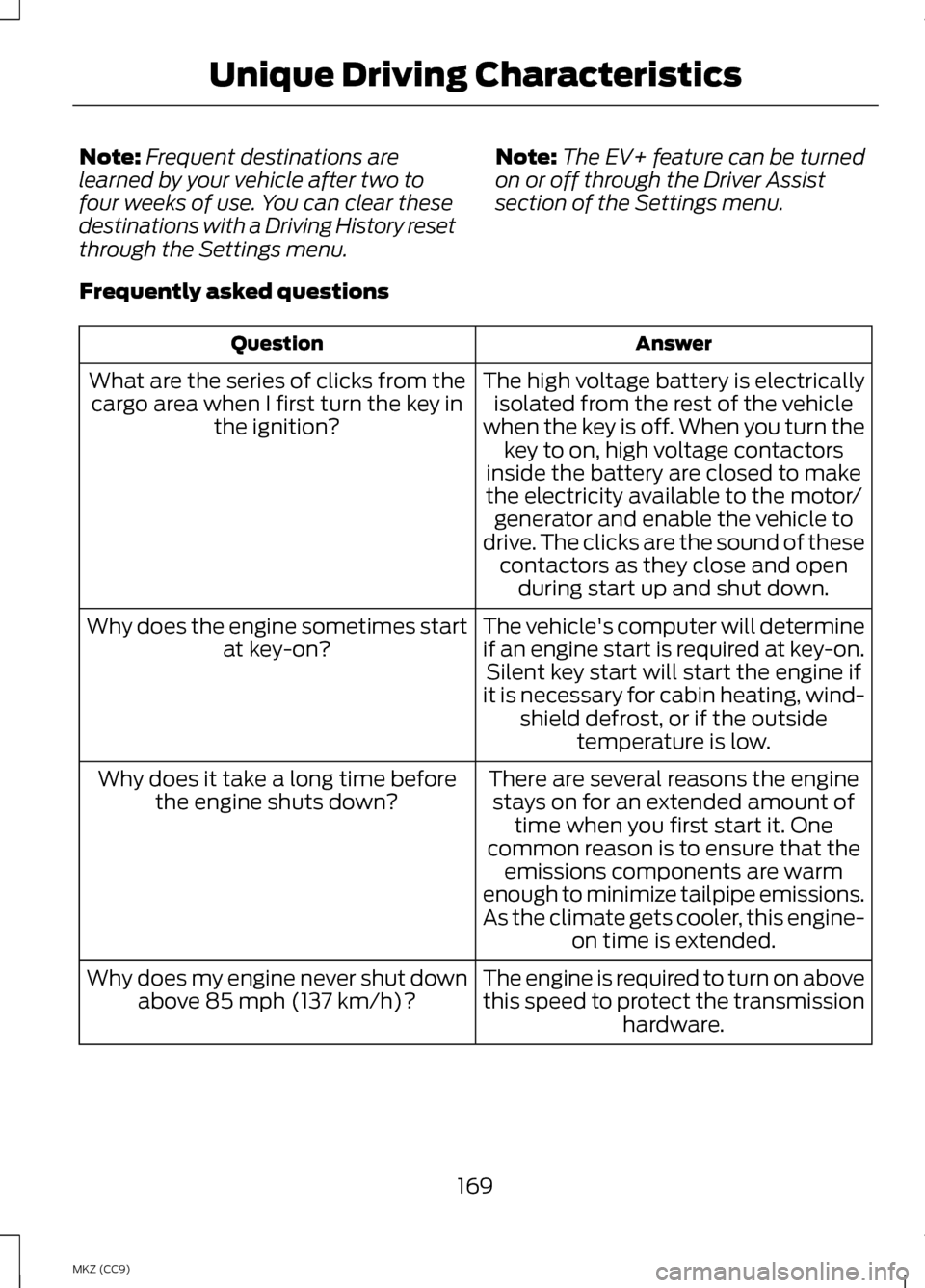
Note:
Frequent destinations are
learned by your vehicle after two to
four weeks of use. You can clear these
destinations with a Driving History reset
through the Settings menu. Note:
The EV+ feature can be turned
on or off through the Driver Assist
section of the Settings menu.
Frequently asked questions Answer
Question
The high voltage battery is electricallyisolated from the rest of the vehicle
when the key is off. When you turn the key to on, high voltage contactors
inside the battery are closed to make
the electricity available to the motor/ generator and enable the vehicle to
drive. The clicks are the sound of these contactors as they close and open during start up and shut down.
What are the series of clicks from the
cargo area when I first turn the key in the ignition?
The vehicle's computer will determine
if an engine start is required at key-on.Silent key start will start the engine if
it is necessary for cabin heating, wind- shield defrost, or if the outside temperature is low.
Why does the engine sometimes start
at key-on?
There are several reasons the enginestays on for an extended amount of time when you first start it. One
common reason is to ensure that the emissions components are warm
enough to minimize tailpipe emissions.
As the climate gets cooler, this engine- on time is extended.
Why does it take a long time before
the engine shuts down?
The engine is required to turn on above
this speed to protect the transmissionhardware.
Why does my engine never shut down
above 85 mph (137 km/h)?
169
MKZ (CC9) Unique Driving Characteristics
Page 172 of 475
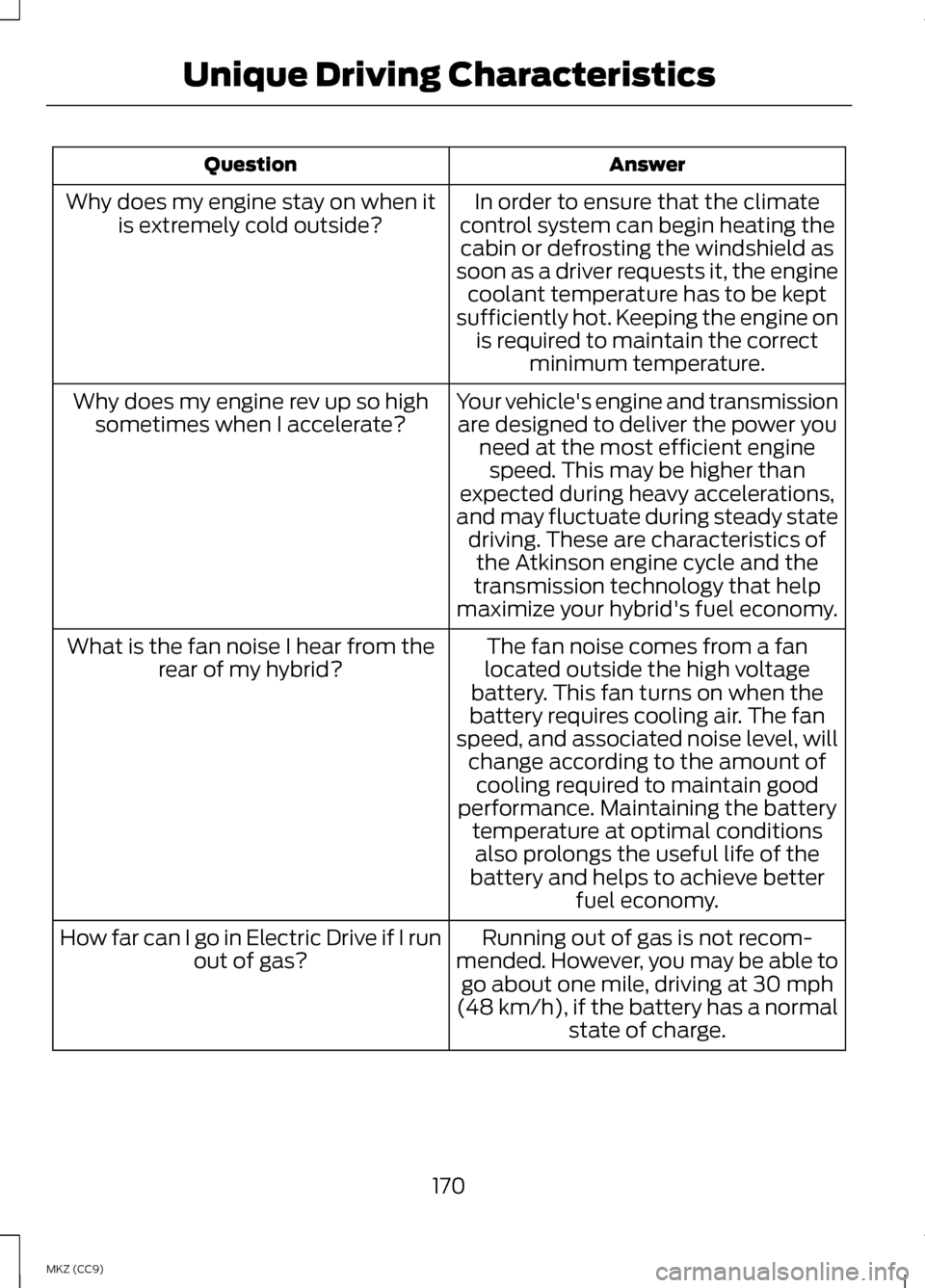
Answer
Question
In order to ensure that the climate
control system can begin heating the cabin or defrosting the windshield as
soon as a driver requests it, the engine coolant temperature has to be kept
sufficiently hot. Keeping the engine on is required to maintain the correct minimum temperature.
Why does my engine stay on when it
is extremely cold outside?
Your vehicle's engine and transmissionare designed to deliver the power you need at the most efficient enginespeed. This may be higher than
expected during heavy accelerations,
and may fluctuate during steady state driving. These are characteristics ofthe Atkinson engine cycle and the
transmission technology that help
maximize your hybrid's fuel economy.
Why does my engine rev up so high
sometimes when I accelerate?
The fan noise comes from a fan
located outside the high voltage
battery. This fan turns on when the
battery requires cooling air. The fan
speed, and associated noise level, will change according to the amount of
What is the fan noise I hear from the
rear of my hybrid?
cooling required to maintain good
performance. Maintaining the battery temperature at optimal conditionsalso prolongs the useful life of the
battery and helps to achieve better fuel economy.
Running out of gas is not recom-
mended. However, you may be able to go about one mile, driving at 30 mph
(48 km/h), if the battery has a normal state of charge.
How far can I go in Electric Drive if I run
out of gas?
170
MKZ (CC9) Unique Driving Characteristics
Page 173 of 475
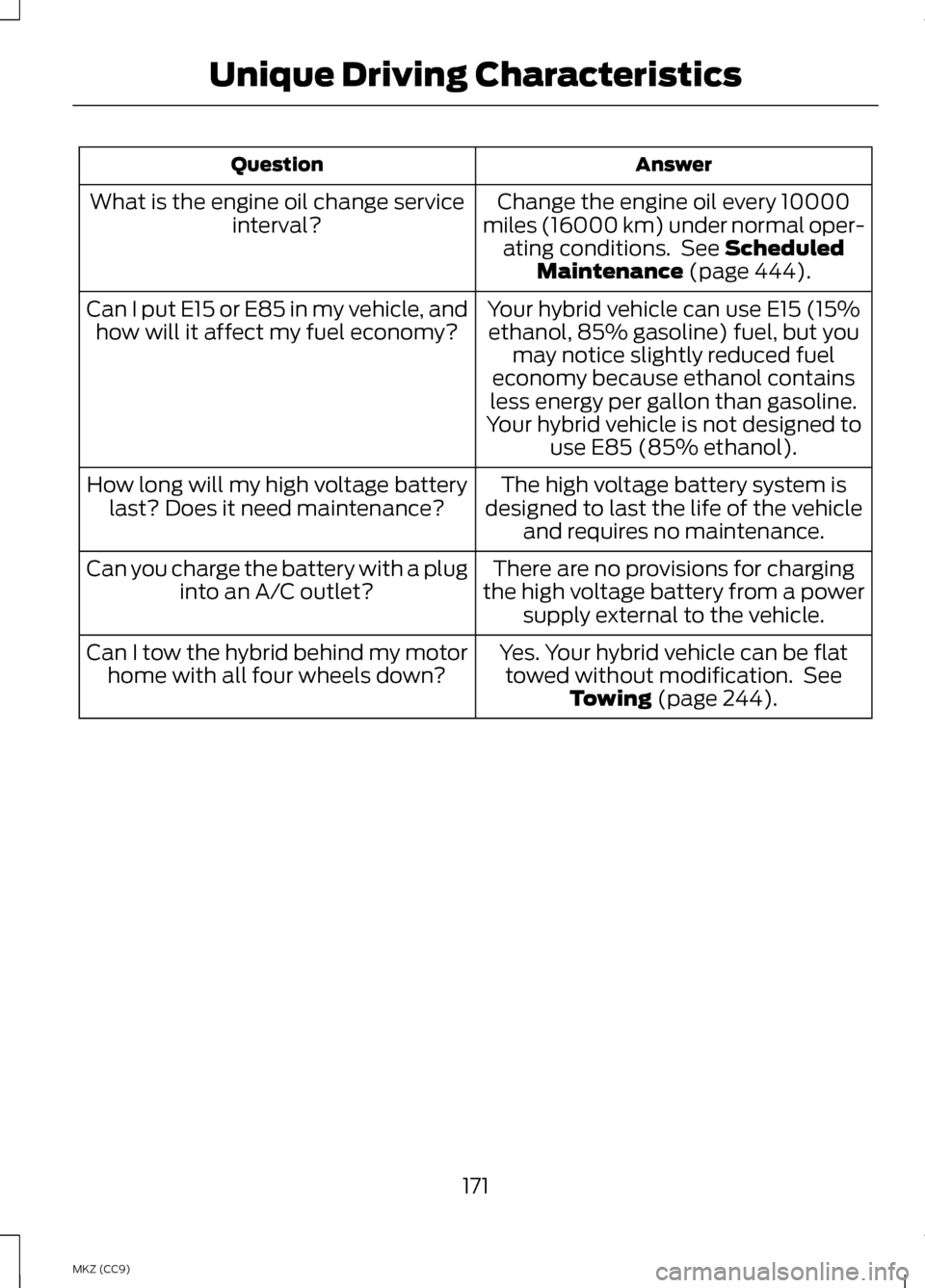
Answer
Question
Change the engine oil every 10000
miles (16000 km) under normal oper- ating conditions. See Scheduled
Maintenance (page 444).
What is the engine oil change service
interval?
Your hybrid vehicle can use E15 (15%ethanol, 85% gasoline) fuel, but you may notice slightly reduced fuel
economy because ethanol contains
less energy per gallon than gasoline.
Your hybrid vehicle is not designed to use E85 (85% ethanol).
Can I put E15 or E85 in my vehicle, and
how will it affect my fuel economy?
The high voltage battery system is
designed to last the life of the vehicle and requires no maintenance.
How long will my high voltage battery
last? Does it need maintenance?
There are no provisions for charging
the high voltage battery from a power supply external to the vehicle.
Can you charge the battery with a plug
into an A/C outlet?
Yes. Your hybrid vehicle can be flattowed without modification. See Towing
(page 244).
Can I tow the hybrid behind my motor
home with all four wheels down?
171
MKZ (CC9) Unique Driving Characteristics
Page 174 of 475
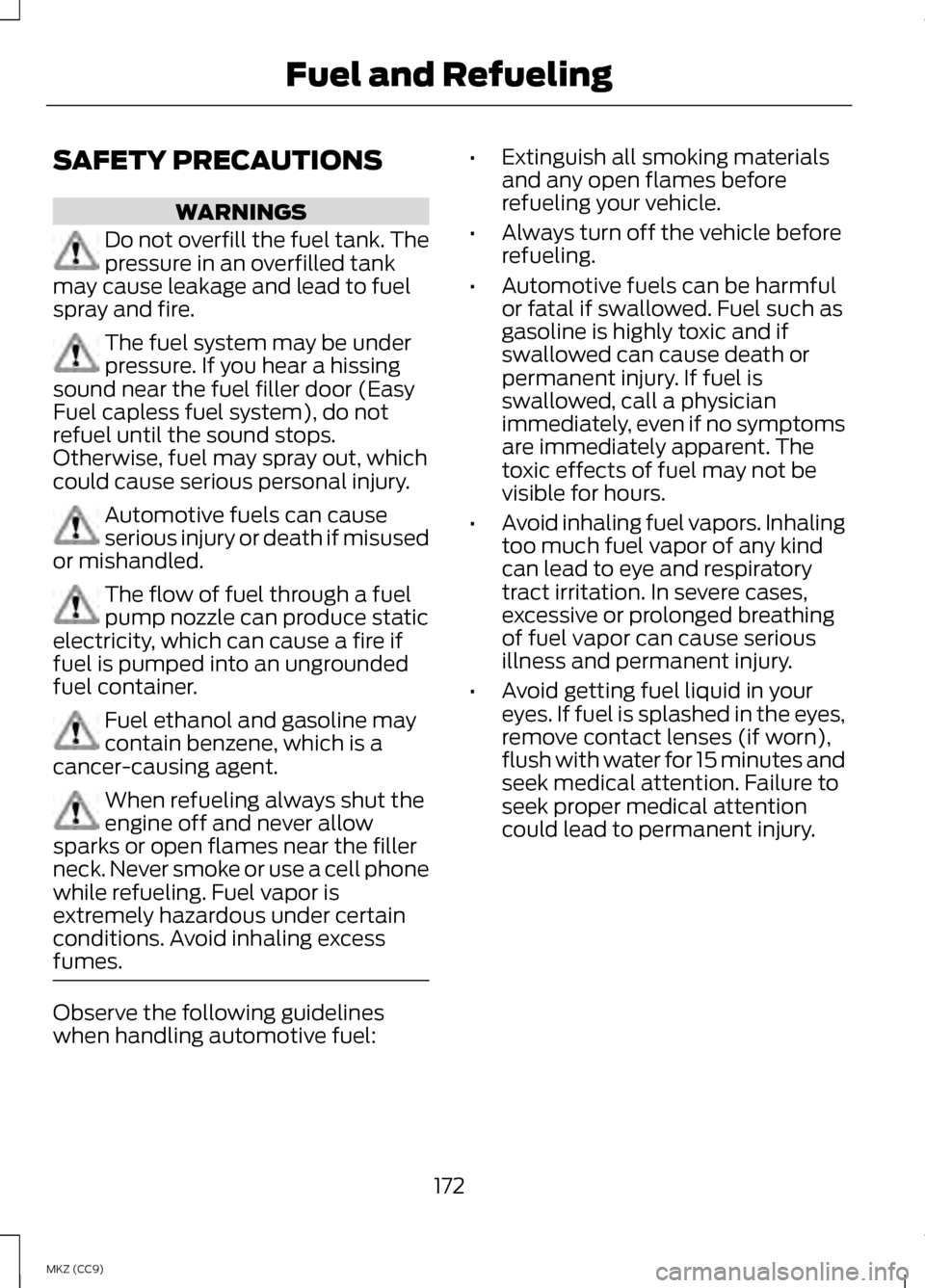
SAFETY PRECAUTIONS
WARNINGS
Do not overfill the fuel tank. The
pressure in an overfilled tank
may cause leakage and lead to fuel
spray and fire. The fuel system may be under
pressure. If you hear a hissing
sound near the fuel filler door (Easy
Fuel capless fuel system), do not
refuel until the sound stops.
Otherwise, fuel may spray out, which
could cause serious personal injury. Automotive fuels can cause
serious injury or death if misused
or mishandled. The flow of fuel through a fuel
pump nozzle can produce static
electricity, which can cause a fire if
fuel is pumped into an ungrounded
fuel container. Fuel ethanol and gasoline may
contain benzene, which is a
cancer-causing agent. When refueling always shut the
engine off and never allow
sparks or open flames near the filler
neck. Never smoke or use a cell phone
while refueling. Fuel vapor is
extremely hazardous under certain
conditions. Avoid inhaling excess
fumes. Observe the following guidelines
when handling automotive fuel: •
Extinguish all smoking materials
and any open flames before
refueling your vehicle.
• Always turn off the vehicle before
refueling.
• Automotive fuels can be harmful
or fatal if swallowed. Fuel such as
gasoline is highly toxic and if
swallowed can cause death or
permanent injury. If fuel is
swallowed, call a physician
immediately, even if no symptoms
are immediately apparent. The
toxic effects of fuel may not be
visible for hours.
• Avoid inhaling fuel vapors. Inhaling
too much fuel vapor of any kind
can lead to eye and respiratory
tract irritation. In severe cases,
excessive or prolonged breathing
of fuel vapor can cause serious
illness and permanent injury.
• Avoid getting fuel liquid in your
eyes. If fuel is splashed in the eyes,
remove contact lenses (if worn),
flush with water for 15 minutes and
seek medical attention. Failure to
seek proper medical attention
could lead to permanent injury.
172
MKZ (CC9) Fuel and Refueling
Page 175 of 475
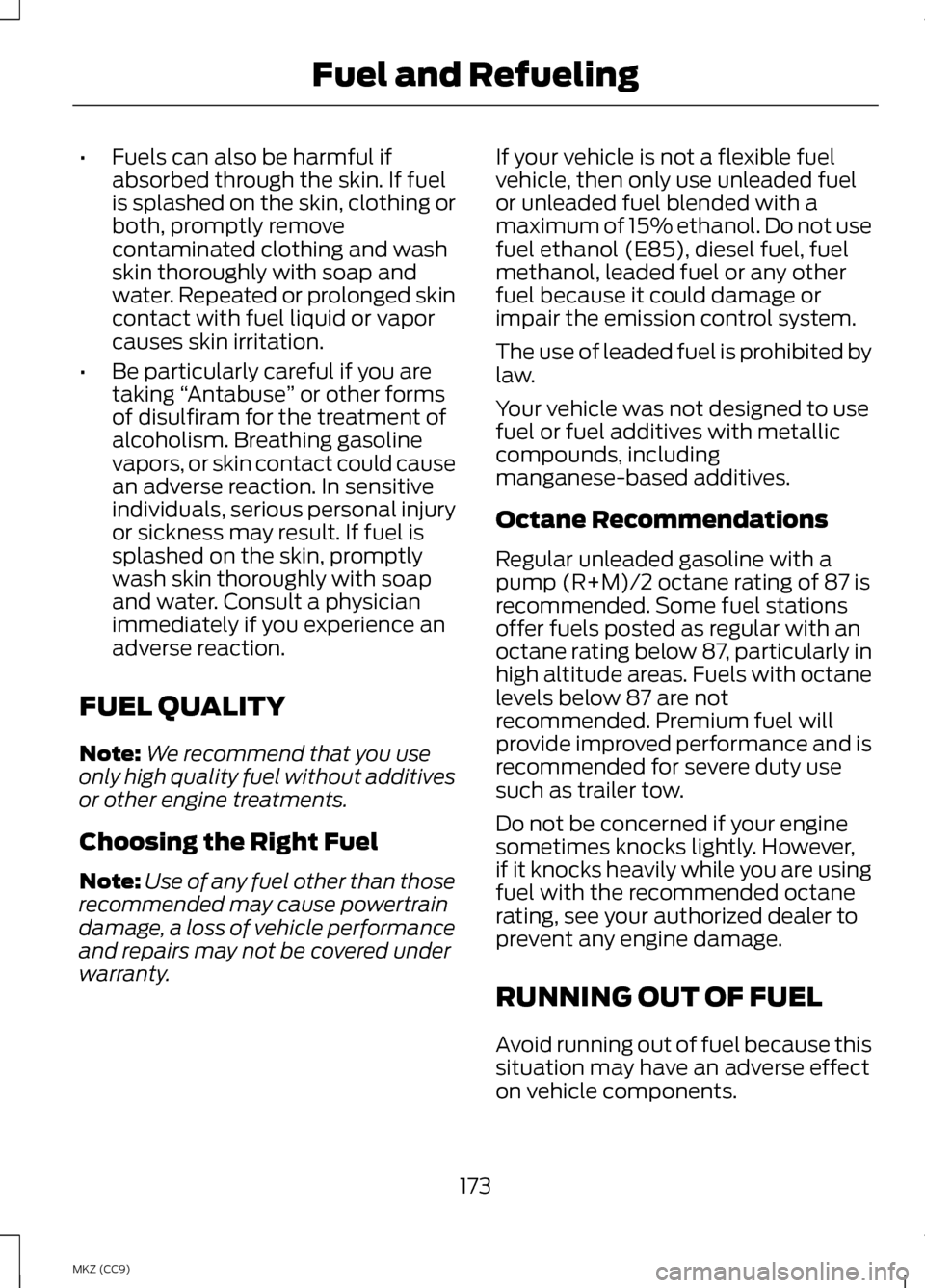
•
Fuels can also be harmful if
absorbed through the skin. If fuel
is splashed on the skin, clothing or
both, promptly remove
contaminated clothing and wash
skin thoroughly with soap and
water. Repeated or prolonged skin
contact with fuel liquid or vapor
causes skin irritation.
• Be particularly careful if you are
taking “Antabuse ” or other forms
of disulfiram for the treatment of
alcoholism. Breathing gasoline
vapors, or skin contact could cause
an adverse reaction. In sensitive
individuals, serious personal injury
or sickness may result. If fuel is
splashed on the skin, promptly
wash skin thoroughly with soap
and water. Consult a physician
immediately if you experience an
adverse reaction.
FUEL QUALITY
Note: We recommend that you use
only high quality fuel without additives
or other engine treatments.
Choosing the Right Fuel
Note: Use of any fuel other than those
recommended may cause powertrain
damage, a loss of vehicle performance
and repairs may not be covered under
warranty. If your vehicle is not a flexible fuel
vehicle, then only use unleaded fuel
or unleaded fuel blended with a
maximum of 15% ethanol. Do not use
fuel ethanol (E85), diesel fuel, fuel
methanol, leaded fuel or any other
fuel because it could damage or
impair the emission control system.
The use of leaded fuel is prohibited by
law.
Your vehicle was not designed to use
fuel or fuel additives with metallic
compounds, including
manganese-based additives.
Octane Recommendations
Regular unleaded gasoline with a
pump (R+M)/2 octane rating of 87 is
recommended. Some fuel stations
offer fuels posted as regular with an
octane rating below 87, particularly in
high altitude areas. Fuels with octane
levels below 87 are not
recommended. Premium fuel will
provide improved performance and is
recommended for severe duty use
such as trailer tow.
Do not be concerned if your engine
sometimes knocks lightly. However,
if it knocks heavily while you are using
fuel with the recommended octane
rating, see your authorized dealer to
prevent any engine damage.
RUNNING OUT OF FUEL
Avoid running out of fuel because this
situation may have an adverse effect
on vehicle components.
173
MKZ (CC9) Fuel and Refueling
Page 176 of 475
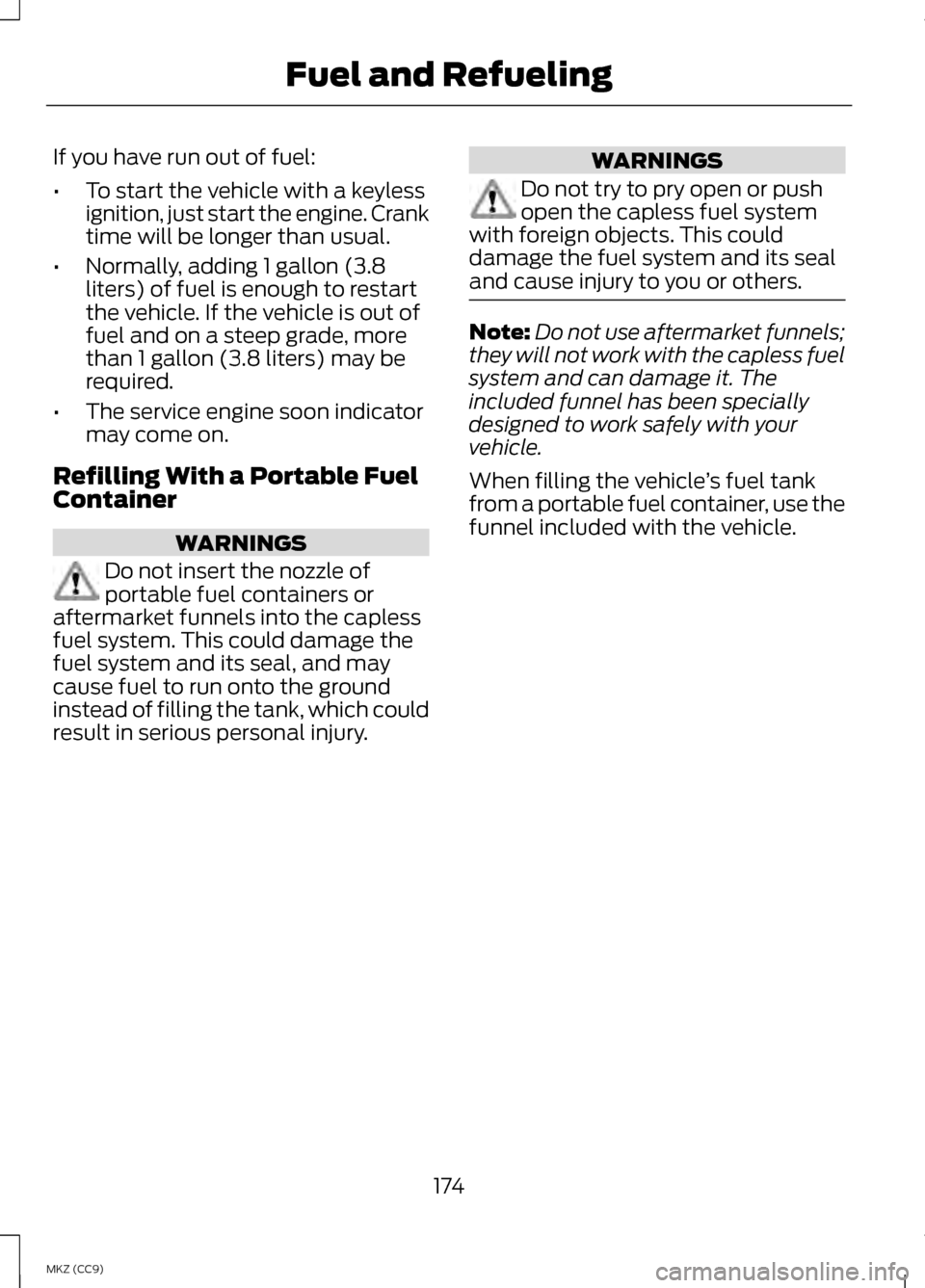
If you have run out of fuel:
•
To start the vehicle with a keyless
ignition, just start the engine. Crank
time will be longer than usual.
• Normally, adding 1 gallon (3.8
liters) of fuel is enough to restart
the vehicle. If the vehicle is out of
fuel and on a steep grade, more
than 1 gallon (3.8 liters) may be
required.
• The service engine soon indicator
may come on.
Refilling With a Portable Fuel
Container WARNINGS
Do not insert the nozzle of
portable fuel containers or
aftermarket funnels into the capless
fuel system. This could damage the
fuel system and its seal, and may
cause fuel to run onto the ground
instead of filling the tank, which could
result in serious personal injury. WARNINGS
Do not try to pry open or push
open the capless fuel system
with foreign objects. This could
damage the fuel system and its seal
and cause injury to you or others. Note:
Do not use aftermarket funnels;
they will not work with the capless fuel
system and can damage it. The
included funnel has been specially
designed to work safely with your
vehicle.
When filling the vehicle ’s fuel tank
from a portable fuel container, use the
funnel included with the vehicle.
174
MKZ (CC9) Fuel and Refueling
Page 177 of 475
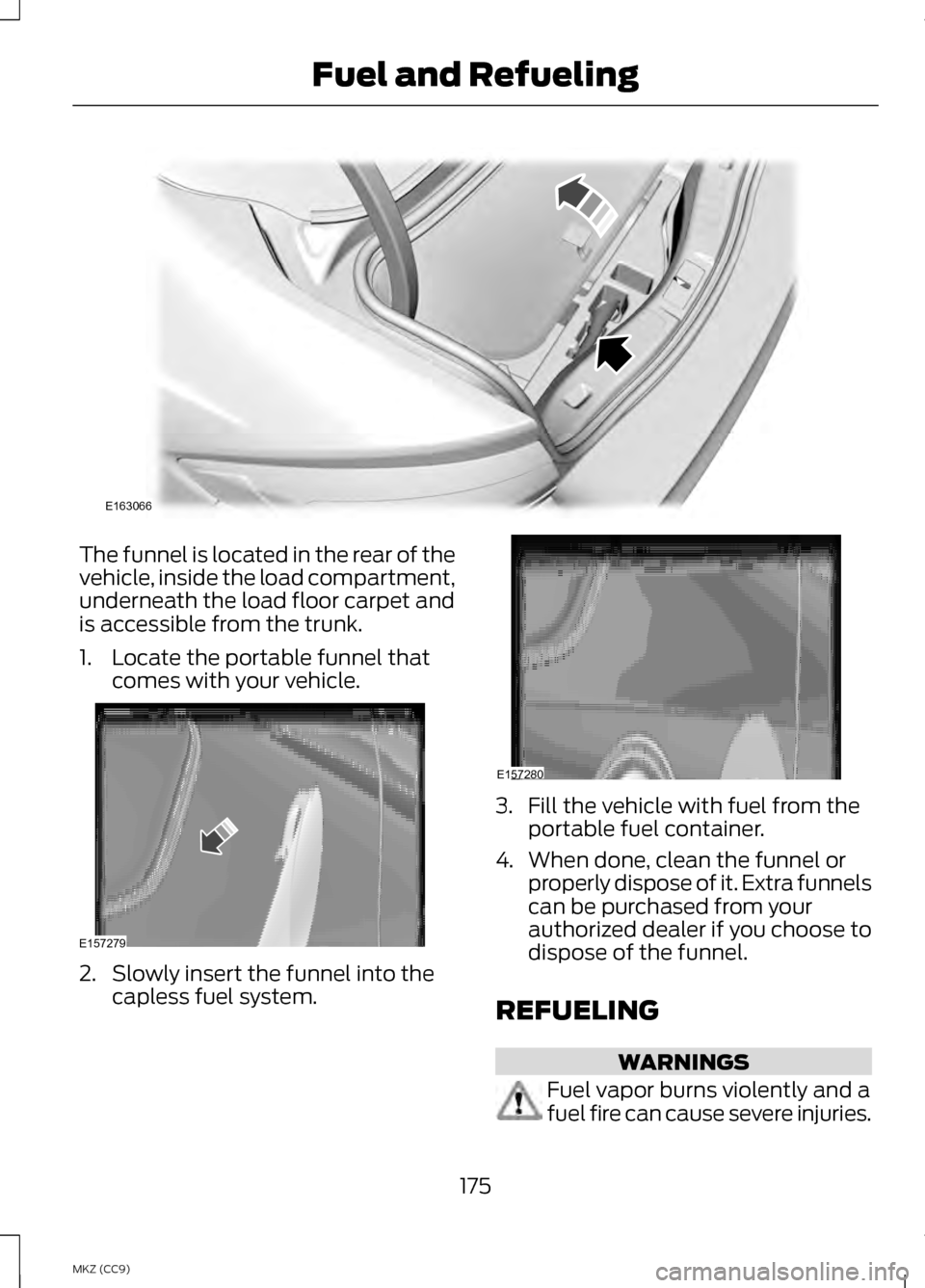
The funnel is located in the rear of the
vehicle, inside the load compartment,
underneath the load floor carpet and
is accessible from the trunk.
1. Locate the portable funnel that
comes with your vehicle. 2. Slowly insert the funnel into the
capless fuel system. 3. Fill the vehicle with fuel from the
portable fuel container.
4. When done, clean the funnel or properly dispose of it. Extra funnels
can be purchased from your
authorized dealer if you choose to
dispose of the funnel.
REFUELING WARNINGS
Fuel vapor burns violently and a
fuel fire can cause severe injuries.
175
MKZ (CC9) Fuel and RefuelingE163066 E157279 E157280
Page 178 of 475
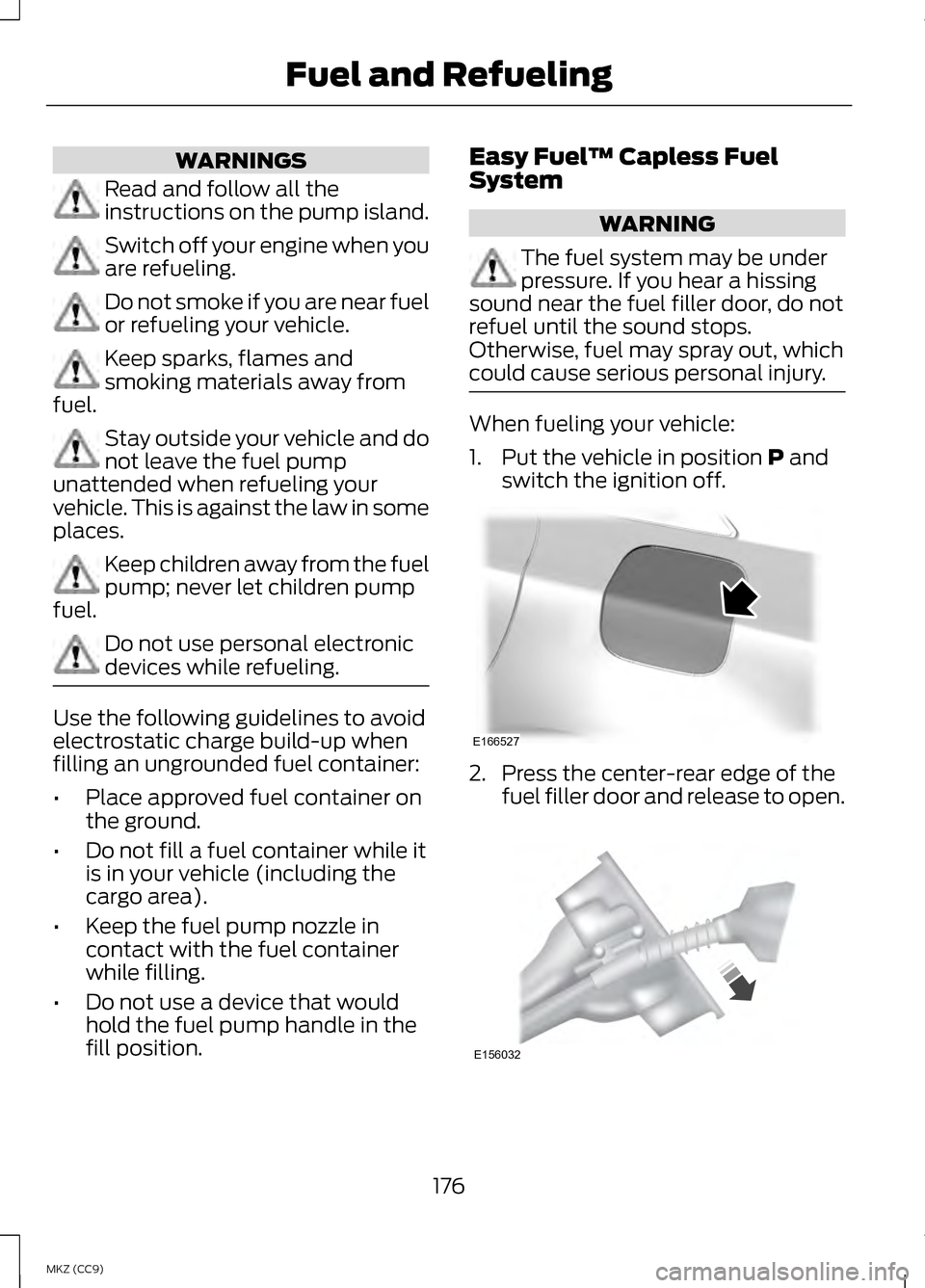
WARNINGS
Read and follow all the
instructions on the pump island.
Switch off your engine when you
are refueling.
Do not smoke if you are near fuel
or refueling your vehicle.
Keep sparks, flames and
smoking materials away from
fuel. Stay outside your vehicle and do
not leave the fuel pump
unattended when refueling your
vehicle. This is against the law in some
places. Keep children away from the fuel
pump; never let children pump
fuel. Do not use personal electronic
devices while refueling.
Use the following guidelines to avoid
electrostatic charge build-up when
filling an ungrounded fuel container:
•
Place approved fuel container on
the ground.
• Do not fill a fuel container while it
is in your vehicle (including the
cargo area).
• Keep the fuel pump nozzle in
contact with the fuel container
while filling.
• Do not use a device that would
hold the fuel pump handle in the
fill position. Easy Fuel
™ Capless Fuel
System WARNING
The fuel system may be under
pressure. If you hear a hissing
sound near the fuel filler door, do not
refuel until the sound stops.
Otherwise, fuel may spray out, which
could cause serious personal injury. When fueling your vehicle:
1. Put the vehicle in position P and
switch the ignition off. 2. Press the center-rear edge of the
fuel filler door and release to open. 176
MKZ (CC9) Fuel and RefuelingE166527 E156032
Page 179 of 475
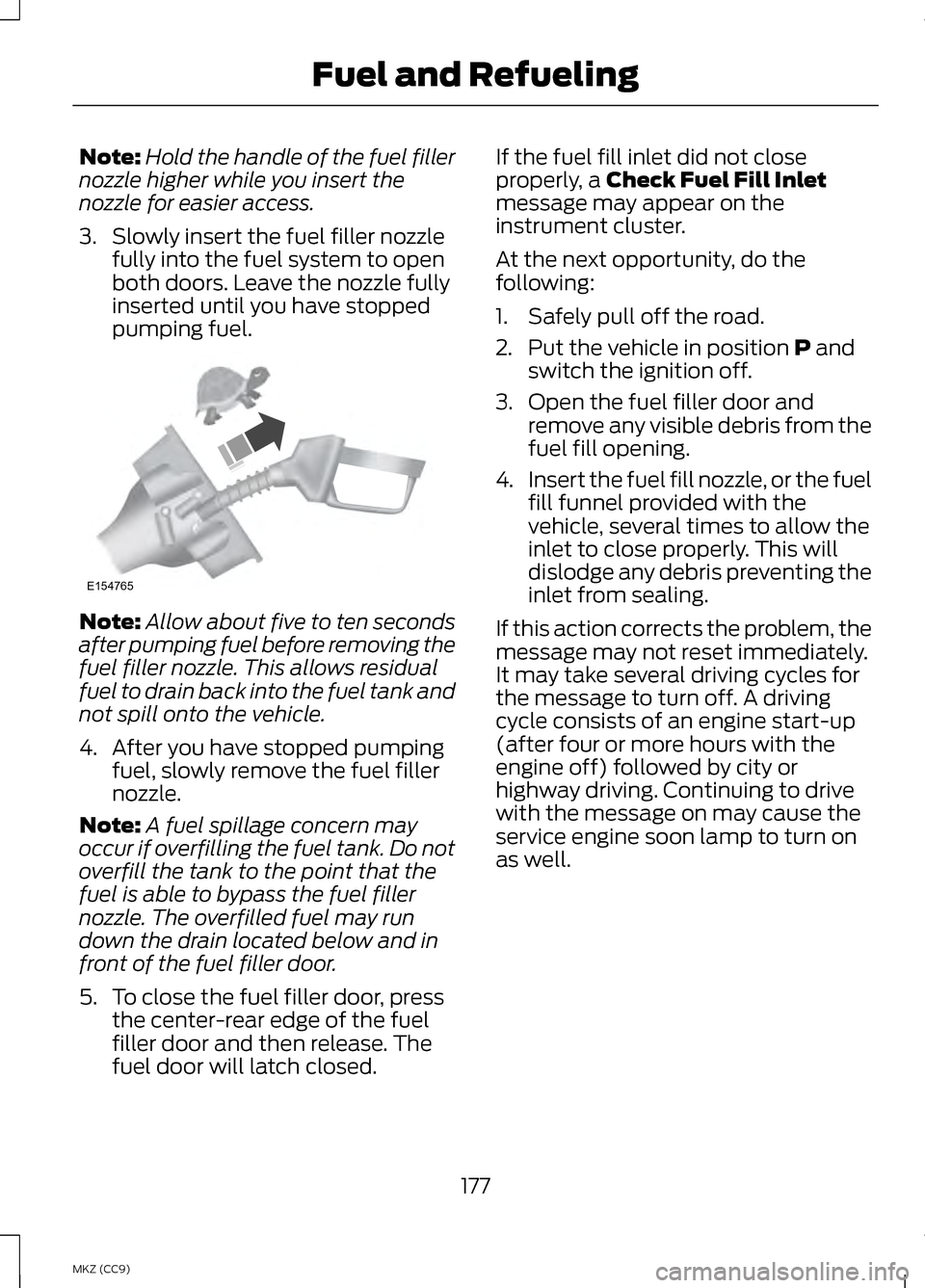
Note:
Hold the handle of the fuel filler
nozzle higher while you insert the
nozzle for easier access.
3. Slowly insert the fuel filler nozzle fully into the fuel system to open
both doors. Leave the nozzle fully
inserted until you have stopped
pumping fuel. Note:
Allow about five to ten seconds
after pumping fuel before removing the
fuel filler nozzle. This allows residual
fuel to drain back into the fuel tank and
not spill onto the vehicle.
4. After you have stopped pumping fuel, slowly remove the fuel filler
nozzle.
Note: A fuel spillage concern may
occur if overfilling the fuel tank. Do not
overfill the tank to the point that the
fuel is able to bypass the fuel filler
nozzle. The overfilled fuel may run
down the drain located below and in
front of the fuel filler door.
5. To close the fuel filler door, press the center-rear edge of the fuel
filler door and then release. The
fuel door will latch closed. If the fuel fill inlet did not close
properly, a Check Fuel Fill Inlet
message may appear on the
instrument cluster.
At the next opportunity, do the
following:
1. Safely pull off the road.
2. Put the vehicle in position
P and
switch the ignition off.
3. Open the fuel filler door and remove any visible debris from the
fuel fill opening.
4. Insert the fuel fill nozzle, or the fuel
fill funnel provided with the
vehicle, several times to allow the
inlet to close properly. This will
dislodge any debris preventing the
inlet from sealing.
If this action corrects the problem, the
message may not reset immediately.
It may take several driving cycles for
the message to turn off. A driving
cycle consists of an engine start-up
(after four or more hours with the
engine off) followed by city or
highway driving. Continuing to drive
with the message on may cause the
service engine soon lamp to turn on
as well.
177
MKZ (CC9) Fuel and RefuelingE154765
Page 180 of 475
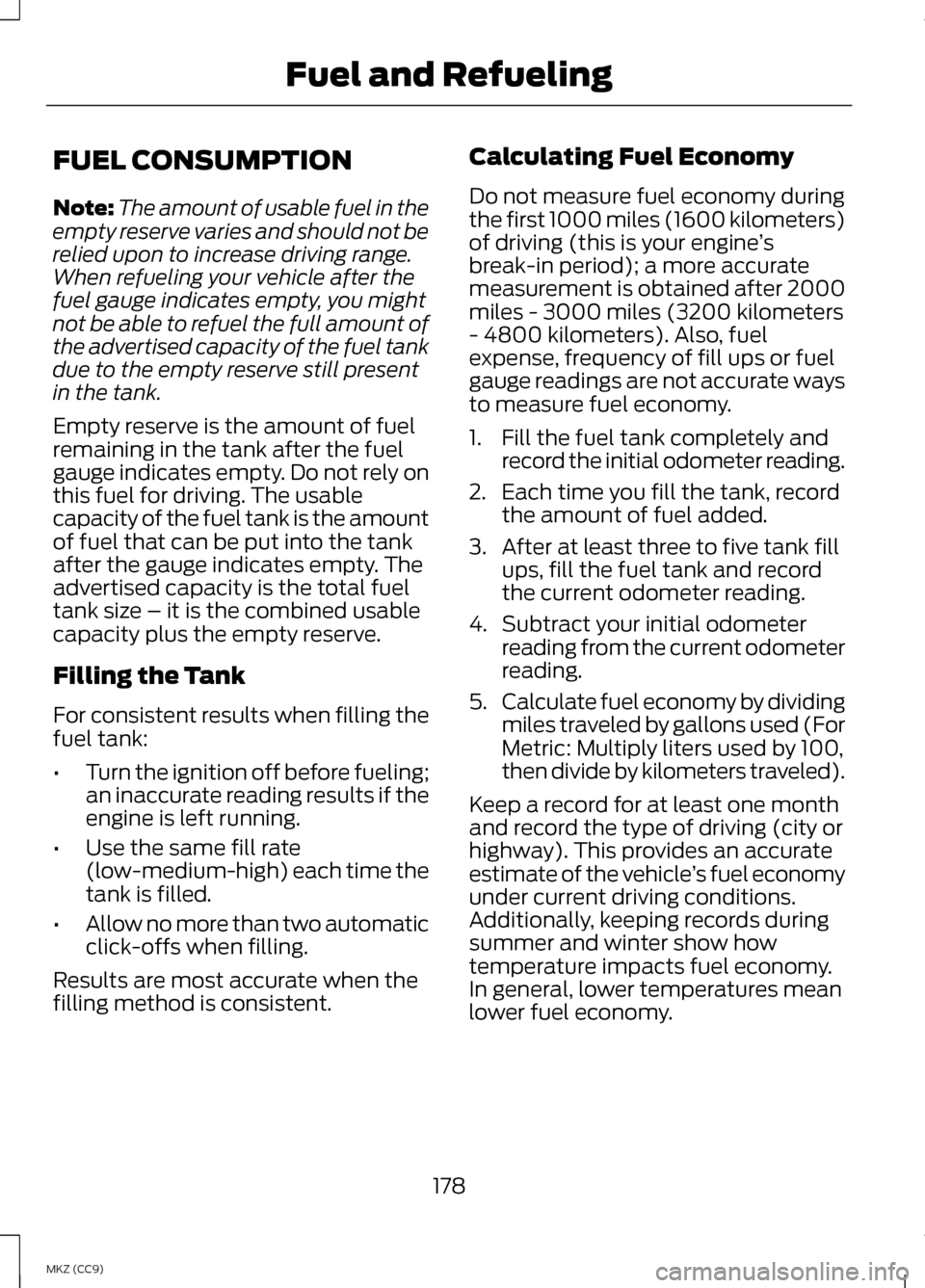
FUEL CONSUMPTION
Note:
The amount of usable fuel in the
empty reserve varies and should not be
relied upon to increase driving range.
When refueling your vehicle after the
fuel gauge indicates empty, you might
not be able to refuel the full amount of
the advertised capacity of the fuel tank
due to the empty reserve still present
in the tank.
Empty reserve is the amount of fuel
remaining in the tank after the fuel
gauge indicates empty. Do not rely on
this fuel for driving. The usable
capacity of the fuel tank is the amount
of fuel that can be put into the tank
after the gauge indicates empty. The
advertised capacity is the total fuel
tank size – it is the combined usable
capacity plus the empty reserve.
Filling the Tank
For consistent results when filling the
fuel tank:
• Turn the ignition off before fueling;
an inaccurate reading results if the
engine is left running.
• Use the same fill rate
(low-medium-high) each time the
tank is filled.
• Allow no more than two automatic
click-offs when filling.
Results are most accurate when the
filling method is consistent. Calculating Fuel Economy
Do not measure fuel economy during
the first 1000 miles (1600 kilometers)
of driving (this is your engine
’s
break-in period); a more accurate
measurement is obtained after 2000
miles - 3000 miles (3200 kilometers
- 4800 kilometers). Also, fuel
expense, frequency of fill ups or fuel
gauge readings are not accurate ways
to measure fuel economy.
1. Fill the fuel tank completely and record the initial odometer reading.
2. Each time you fill the tank, record the amount of fuel added.
3. After at least three to five tank fill ups, fill the fuel tank and record
the current odometer reading.
4. Subtract your initial odometer reading from the current odometer
reading.
5. Calculate fuel economy by dividing
miles traveled by gallons used (For
Metric: Multiply liters used by 100,
then divide by kilometers traveled).
Keep a record for at least one month
and record the type of driving (city or
highway). This provides an accurate
estimate of the vehicle ’s fuel economy
under current driving conditions.
Additionally, keeping records during
summer and winter show how
temperature impacts fuel economy.
In general, lower temperatures mean
lower fuel economy.
178
MKZ (CC9) Fuel and Refueling